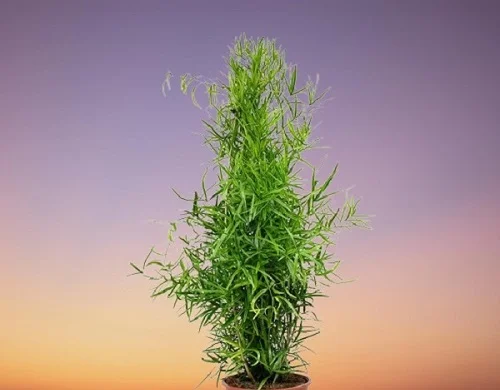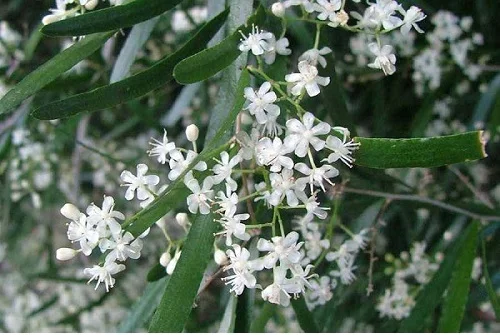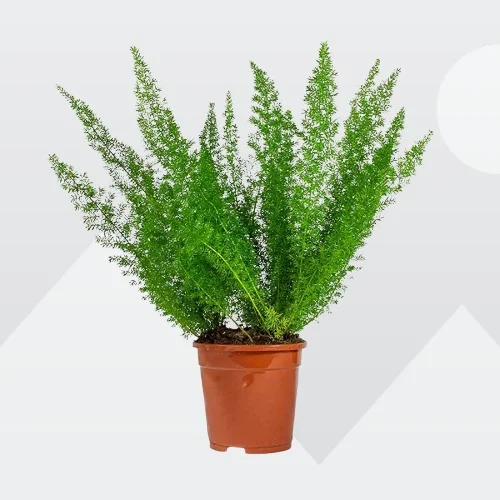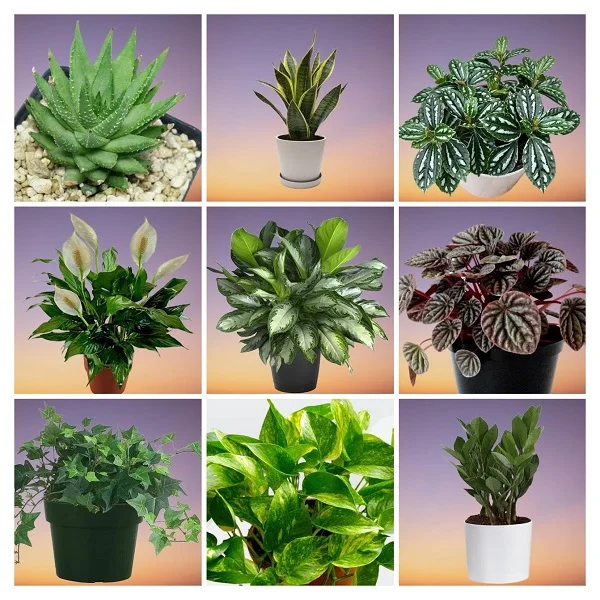Sicklethorn Asparagus (Asparagus falcatus) Care Indoors, Propagation and Problems
Some links in this post may be affiliate links
Sicklethorn Asparagus (Asparagus falcatus) blossoms in medium to bright indirect light, average warmth, moderate humidity and moderately moist, rich, well-drained, all purpose soils coupled with weekly feeding in the growing period.
Asparagus falcatus also called Sicklethorn Fern, Large Forest Asparagus or Sickle-leaved Asparagus is among the popular ornamental Asparagus ferns which bears sickle-shaped 'leaves' and the stems are distinctly prickly, hence the common name, 'Sicklethorn Asparagus'.
Large Forest Asparagus is a large, thorny, climbing plant whose 'leaves' (not true leaves) are dark-green, thin, curved and about 2 inches long.
Though commonly called a fern, Sicklethorn Fern is not among the True Ferns as it is much easier to grow than true ferns. It adapts well to wide variations in light, heat and watering frequency.

Botanical name: Asparagus falcatus
Family: Asparagaceae
Sufamily: Asparagoideae
Common names: Sicklethorn Asparagus, Sicklethorn Fern, Large Forest Asparagus, Sickle-leaved Asparagus
Origin
Asparagus falcatus is native to South Africa and Mozambique.
Size
Large Forest Asparagus stems can grow up to 8 feet high and can be trained to grow up a moss pole making it one of the best low-light large plants for the living room.
Flower
Sickle-leaved Asparagus may produce fragrant white flowers which are followed by bright red berries when provided with the right growing conditions.
Invasiveness
As indicated by Mark Tancig (University of Florida), Asparagus Ferns have been found to be invasive in some regions. Avoid growing Asparagus Ferns in the ground and dispose them by burning as they grow vigorously, spreading across and scrambling up other plants.
Toxicity
Sicklethorn Asparagus like other Asparagus Ferns is toxic to humans and pets as indicated by ASPCA. If the berries are ingested, they can cause vomiting, diarrhea and abdominal pain. If handled with bare hands, the berries can cause contact dermatitis.
The foliage of mature ferns can develop sharp spines on the branches which can cause skin irritation if handled with bare hands. Therefore, always wear gloves when handling Sickle-leaved Asparagus.
Where to Buy
If you would like to add Asparagus ferns to your collection. Check them out on Etsy (Link to Etsy).

Sicklethorn Asparagus Care Indoors
Sicklethorn Asparagus (Asparagus falcatus) blossoms in medium to bright indirect light, average warmth of 15-280C, moderate humidity of 50-55% and moderately moist, rich, well-drained, all purpose soils coupled with weekly feeding during the growing period.
Asparagus falcatus care also requires pruning to keep it tidy as well as reduce pest and disease infestations. Repotting is needed only when it becomes root-bound. Keep reading for more on these growing conditions and how to achieve them.
Watering
Water your Sicklethorn Asparagus liberally during the growing season and allow the top 2-3 inches of soil to dry out between waterings to keep the soil moderately moist.
Reduce watering in the cold period as growth is reduced at this time but do not let the soil dry out completely to avoid leaf drop.
Once in a while water the Large Forest Asparagus from the bottom to ensure that the soil ball is thoroughly wetted.
Confirm that the pot has a drainage hole to prevent the soil from getting soggy as it can lead to root-rot disease and eventual death of the fern.
Light Requirements
Sicklethorn Asparagus grows best in medium to bright indirect light (dappled light). Keep it away from direct sunlight as it can cause scorching of the leaves.
Lack of enough light causes the leaves to loss their color, turning them yellowish. Where the natural lighting is not sufficient, consider investing in grow lights. Check out these full spectrum grow lights on Amazon.
Temperature and Humidity
Average warmth of 15-280C is ideal for Sicklethorn Asparagus. Though it can adapt to a wide range of temperatures, constantly high temperatures can cause yellowing and dropping of the leaves.
Sicklethorn Fern requires a humidity of 50-55%, it has no need for extra humidity. However, it will benefit from occasional misting of the leaves especially when the temperatures are high.
Potting Mix
The best potting mix for Sicklethorn Asparagus should be rich in organic matter and free-draining to prevent it from getting soggy while providing the required nutrients. All purpose potting mixes are perfect for this fern.
Fertilizer
Feed Sicklethorn Asparagus with a balanced, liquid fertilizer weekly during the growing season for lush growth. Do not feed it in the cold season as growth is reduced at this time, therefore, the plant does not need it.
Repotting
Repot Sicklethorn Fern at the beginning of the growing season only when it becomes root-bound, when the roots begin to grow through the drainage holes.
Use a pot only 1 size larger than the current one and ascertain that the soil is loose and free-draining and the pot has a drainage hole to avoid getting soggy soil.
The large Sickle-leaved Asparagus can be divided during repotting to propagate new plants. Check out these pots with drainage holes on Amazon.
Pruning
Pruning Sicklethorn Asparagus requires cutting back of the old stems to make room for new growth. Trim the dead leaves and branches to keep the plant neat and tidy as well as minimize pest and disease infestations.
Propagation
Sicklethorn Asparagus (Asparagus falcatus) propagation can be done at the beginning of the growing season from seeds, cuttings or by plant division during repotting. The easiest method of propagation is by plant division.
Learn how to propagate Asparagus Ferns in 3 easy ways.

Sicklethorn Asparagus Problems
Sicklethorn Asparagus problems are yellowing leaves and dropping leaves, plant dying, diseases and pests among others. Read on for more on these problems, their remedies and solutions.
Leaves yellowing and dropping
There are many possible causes of yellowing and dropping leaves in Sicklethorn Asparagus. One of the possible causes is too little light. Place the fern in a brighter spot where it can receive medium to bright indirect light or instal grow light if the natural lighting is inadequate.
The second possible cause of yellowing and dropping leaves in Sicklethorn Asparagus is that the soil has been allowed to dry out for too long. Water the fern thoroughly during the growing season while allowing the top 2-3 inches of soil to dry out between waterings. Lessen watering in the cold period as growth is reduced at this time but do not allow the soil to dry out completely. Learn more on how to water indoor plants the correct way.
The third possible cause of yellowing and dropping leaves in Sicklethorn Fern is too high temperatures. Maintain an average room temperature within the range of 15-280C by keep it away from hot drafts and sunlight.
Read more on these 12 Reasons Why Asparagus Fern Leaves are Yellowing and Dropping (with solutions)
Pests
The common pests in Sicklethorn Asparagus are whiteflies, mealy bugs, spider mites and aphids whose infestation is promoted by either overwatering or underwatering.
Keep the soil moderately moist during the growing period and slightly moist in the cold period but never let the soil dry out completely to keep these pests away. Isolate the affected plant to prevent spread to other plants and treat it with horticultural oil as directed by the manufacturer.
Plant dying
Sicklethorn Asparagus is dying due to root-rot which is promoted by soggy soil. The thick, tuberous roots store water, therefore, soggy soil will result in root-rot which causes the plant to begin to die. Ensure that the soil is well-drained and that the pot has a drainage hole to avoid getting soggy soil. Learn how to treat root-rot in houseplants.
Diseases
Sicklethorn Fern is prone to crown-rot and stem-rot which is prevalent in poorly ventilated and overwet conditions. Improve ventilation and ensure that there is free air circulation for the plant. Isolated the affected plant to prevent spread to the other plants and treat it for the disease.
You liked it? Share on social media.
Related Content
Amazon Associates Disclosure
Homeplantsguide.com is a participant in the Amazon Services LLC Associates Program, an affiliate advertising program designed to provide a means for sites to earn advertising fees by advertising and linking to amazon.com.





